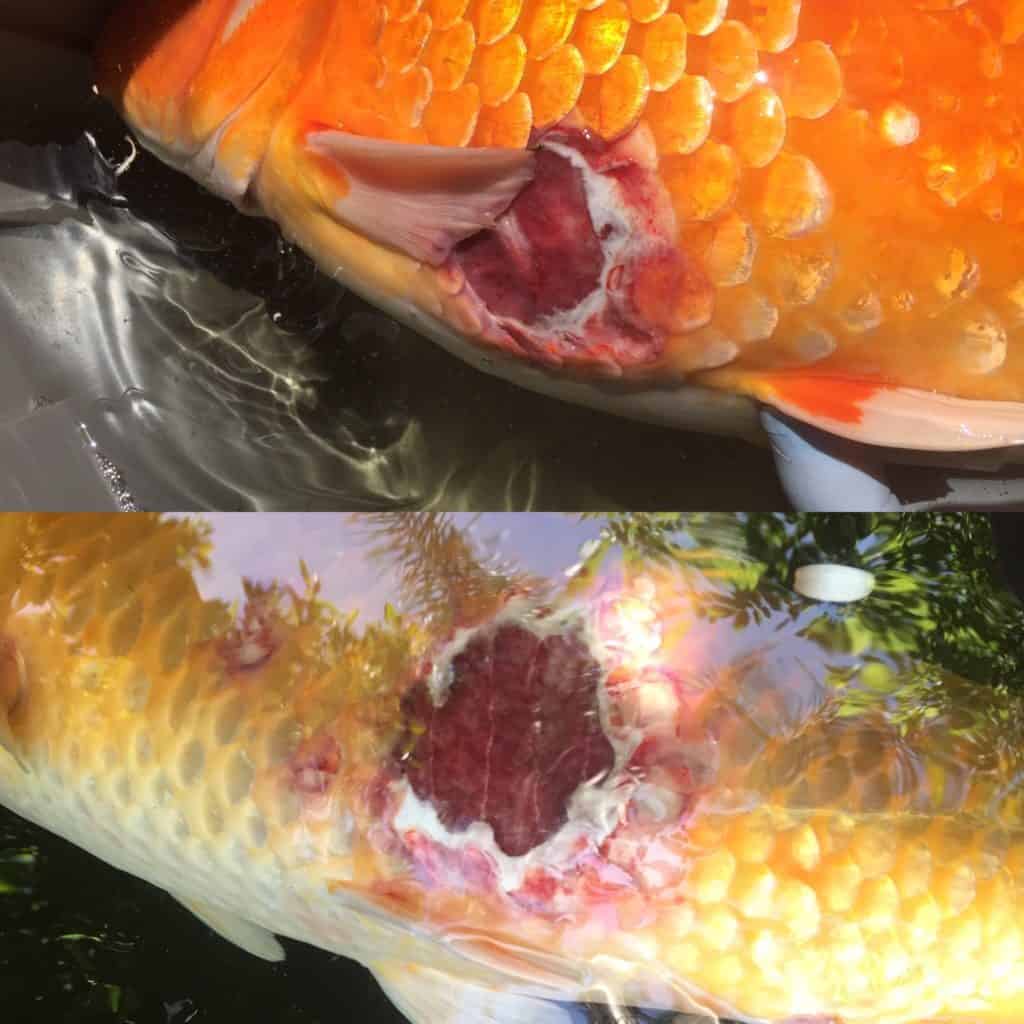One of the most common owner concerns we get calls about are fish ulcers. What is an “ulcer,” how do they come about and how do you fix them?
What is an “ulcer?”
Most commonly, fish get skin ulcers. This is an open wound in the skin of a fish that may expose the underlying musculature. In fish, it can be accompanied by scale loss, local growth of fungus and may appear suddenly or grow slowly over time. They can appear anywhere on the body of the fish.
How do ulcers occur?
Since fish, essentially, live in a toilet, they are constantly fending off external attacks from parasites, bacteria and fungus. Their excellent immune system works hard to keep these invaders from entering a fish’s body. When the immune system slows down or stops working, from fish stressors (#1 = water quality), the invading pathogens get to work on the fish’s most external defense network: the skin.
Once the immune defenses have been breached, fungi and bacteria can get set into a fish’s skin and set up a happy home. Parasites are usually secondary, with a fish’s behavioral flashing opening up sites for bacteria and fungi to enter.
How do you fix fish ulcers?
It is rare for an ulcer to occur spontaneously, without any primary triggers. Most ulcerations are caused secondary to some other stressor (#1 = water quality). Without identifying the primary cause, no matter what you use to treat, the ulcer will return.
Once the primary stressor has been identified and corrected, most mild ulcers will heal on their own. More severe ulcers, especially those penetrating in the muscles, may require antibiotic therapy, prescribed by your aquatic veterinarian. Prescription medicated feeds may be required for a tankwide or pondwide outbreak.
There are some very tough bacterial bugs in the fish world, most commonly Aeromonas and Pseudomonas spp in koi and goldfish, that are capable of causing primary ulcerations. These are VERY RARE and are usually in fish that receive a lot of antibiotic treatment, most commonly over-the-counter drugs for diseases they do not have. They are diagnosed by a culture and sensitivity test, performed by an aquatic diagnostic laboratory. To prevent these highly resistant organisms from getting in your tank, only use antibiotic medications when prescribed by a veterinary professional.
How do I prevent fish ulcers?
Mitigating stress in your fish’s environment is key. The best preventative medicine in fish is good water quality and good diet. If you suspect your fish has an ulcer that is not improving despite checking the above factors, contact your local aquatic veterinarian immediately.


Pingback: Betta Fish Tumor - Japanesefightingfish.org
Pingback: Betta Fish Tumor | How to Treat, Causes, Signs, More - Fish Life Today
You say Aeromonas and Pseudomonas spp are rare for koi. I was always taught they were the main bacteria for ulcers? So what bacteria are the main culprits?
Also people say a salt paste works for ulcers?
Thanks Kirk
Primary bacterial infections involving only a highly infectious bacterial strain are rare. Most bacterial diseases are secondary to other stressors and native in the environment. Salt paste does not cure ulcers.
I have a fancy tail goldfish it has red veins in skins gradualluly showed over time now its fins and tails are damaged and body has some spots too .. I have put it in seperate container now but I don’t know what to do
If you are concerned about your fish, please call (831) 278-1081 for veterinary assistance. If you are outside California and Nevada, please visit https://fishvets.org or https://wavma.org
I am attempting to figure out what is growing on my bettas forehead. Clear blisters started appearing on December 30th. Betta Board members told me different things, but I’m not convinced.
These look like clear blisters on his forehead that seem to pop amd the area looks white. Does not appear to be a pit like HITH would make.
If you are concerned about your fish, please call (831) 278-1081 for veterinary assistance. If you are outside California and Nevada, please visit https://fishvets.org or https://wavma.org
One of our two goldfish has developed a large red bump or blister on his upper back near his dorsal fin. There seems to be another one forming near his tail.
His behavior seems normal otherwise.
If you are concerned about your fish, please call (831) 278-1081 for veterinary assistance. If you are outside California and Nevada, please visit https://fishvets.org or https://wavma.org
Pingback: Bettafix Review - Does it Work?
Pingback: Tumor del pez Betta: Síntomas, causas y tratamiento (Guía completa) - Acuarios y Peces
My rainbow shark has a skin ulcer and he is not getting better despite having used melafix. I have put him in a separate container since the other fish are attacking him and now he’s nt even eating. What should i do? 😱
If you are concerned about your fish, please call (831) 278-1081 for veterinary assistance. If you are outside California and Nevada, please visit https://fishvets.org or https://wavma.org